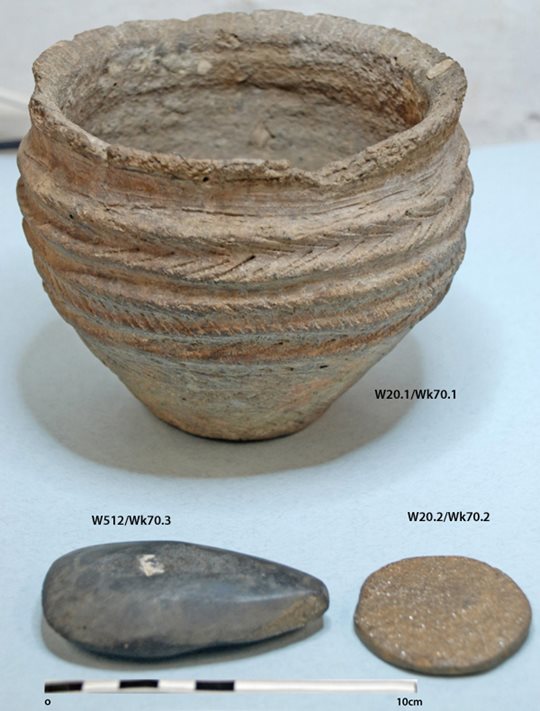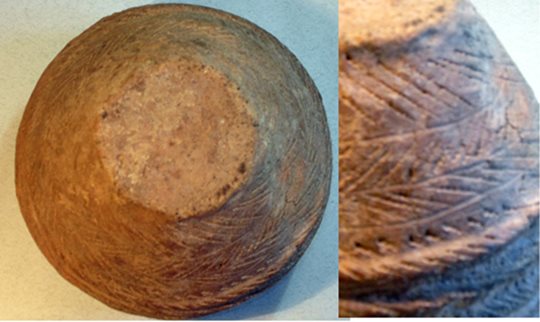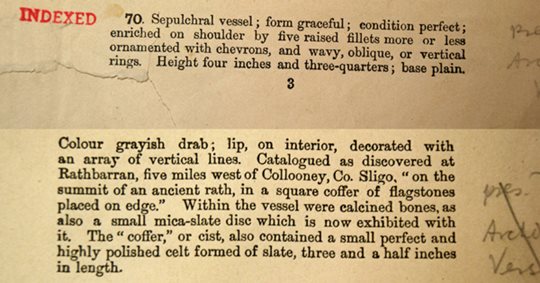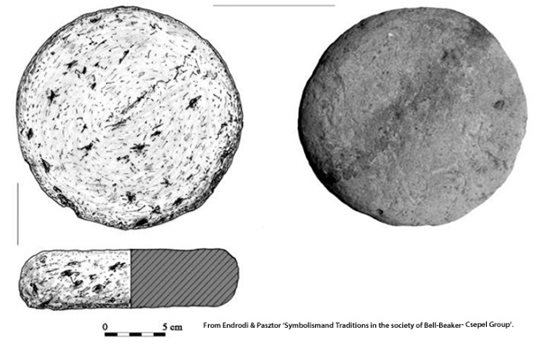Acquired 1890
Rathbarran Lunar Disc
Discovered in county Sligo in the mid-nineteenth century among the Rathbarran grave goods and transferred to the Science and Art Museum in 1890, it has been suggested that this most unusual disc might be a lunar disc.
By Sharon WeadickWhen Archdeacon Joseph Vershoyle was digging an early Bronze Age cist burial at Rathbarran, Co. Sligo in the mid-nineteenth century he must have been somewhat surprised to find a sparkling disc of mica-schist among the grave goods. Vershoyle later donated the grave goods to the Royal Irish Academy (RIA) and they were subsequently transferred to the newly opened Science and Art Museum in 1890. Over a century and a half later it has been suggested that this most unusual disc might be a lunar disc.

What evidence is there to suggest it could be a lunar disc?
The disc appears to have been deliberately worked to create a circular shape to resemble the moon. Additionally, the exposed silver mica crystals on the flat faces give the disc a reflective, lunar-like appearance. Significantly, the Rathbarran burial also contained a decorated ceramic bowl. Pioneering research by Mary Cahill of the NMI has revealed that the same sets of motifs are used to decorate the Early Bronze Age gold discs are used also to decorate Early Bronze Age ceramic Bowls, like the Rathbarran Bowl. This decoration is most apparent when the bowls are viewed from above (Cahill, forthcoming).
From examining the Rathbarran Bowl with Mary Cahill, there appears to be three bands of whirligig motifs, a solar motif representing the rays of the sun. They extend from the base to the first rib on the body of the bowl. The direction of the motif is different in each band. Therefore what makes this a truly exceptional discovery is the presence of a bowl with solar symbolism and a possible lunar disc in a cist burial. This would pre-date both the Nebra Sky-disc and the sun disc on the Trundholm chariot.

The burial
From the accounts in the Museum’s registers this stone disc was recovered from the cist grave within the burial mound. The burial also contained a ceramic Bowl, a polished stone axe and cremated human bone.
Lunar discs and symbolism in the archaeological record
Lunar discs are extremely rare in the archaeological record. The two most important artefacts to date to assist in our understanding of Bronze Age cosmology are the Bronze Age Nebra sky-disc c. 1600 BC and the sun disc from the Trundholm chariot c. 1400BC. On the Nebra sky-disc the moon is represented in two of its phases: the disc of the full moon and the crescent of the new moon. The gold side of the sun disc from the Trundholm chariot is thought to represent the day time sun and the bronze side the nightsun. When researching lunar discs for this article the only parallel found for the Rathbarran disc was a clay disc from the excavation of Budapest-Albertfalva in Hungary. The clay disc turned up in an Early Bronze Age Beaker burial context and it has been interpreted by the excavators as a possible sun or moon disc.
A collections search for stone discs on the British Museum’s website also brought up a few potential examples of lunar discs. The most likely candidate is the stone disc from Kemney in Scotland. Unfortunately details regarding its context and date were too rudimentary to make a more accurate identification.

In other contexts, lunar symbols are frequently depicted in rock art, while the cycle of the moon is closely associated with certain monument types, particularly stone circles. Richard Bradley’s recent excavations of three stone circles in Scotland revealed some insightful connections between stone circles and the moon. He did not limit his research to the close structural associations between the moon and stone circles, but also examined their role as ceremonial arenas and places for scientific observations, where activities were best experienced at night.
To conclude
In the past the moon assisted navigation, its cycle was applied to calculate the days, times for sowing and harvesting. It played an integral part in the belief systems on life, death and rebirth. Although the Rathbarran disc is much simpler in form and function to the Nebra sky-disc or sun disc from the Trundholm chariot, it too would appear to have some cosmological significance. Its purpose may have been to symbolically navigate the deceased to the underworld.

Learn more
These objects are not currently on public display as they are part of the Museum’s reserve collections. Similar objects are on display in the “Prehistoric Ireland” exhibition on the ground floor in the National Museum of Ireland – Archaeology on Kildare Street.
References
Bradley, Richard. 2005. The moon and the bonfires. An investigation of three stone circles in north-east Scotland.
Cahill, Mary (forthcoming) ‘Here comes the sun’ in Archaeology Ireland.
With thanks to Mary Cahill, curator of the Museum’s prehistoric collections, and Matthew Parkes, curator of the Museum’s geological collections.
Location:
Rathbarran Lunar Disc is located at:
In Storage
Previous artefact:
Printing Press Shooter – Printing the Proclamation of Independence
Next artefact:
Relics of the Irish Whaling Industry
